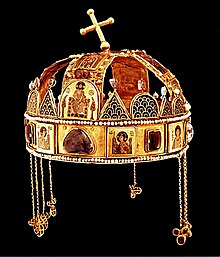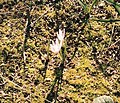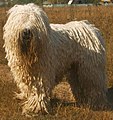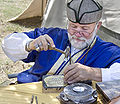National symbols of Hungary


The national symbols of Hungary include flags , icons, or cultural expressions that are symbolic, representative or characteristic of Hungary or Hungarian culture. The highly valued Hungarian products and symbols are called "Hungarica".
Flags and coats of arms
The flag of Hungary consists of three horizontal bars, represented in descending order by the colors red, white and green. The coat of arms of the Árpád dynasty is also very well known.
Flora and fauna
Almost a fifth of the country is forested, but only 10 percent of it is natural forest. Hungary is home to around 2,200 flowering plant species. Due to its topography and transitional climate, most of these species are usually not found at this altitude. Much of the flora in the Villlány and Mecsek Hills in southern Transdanubia is usually only found near the Mediterranean . In 1867 the previously unknown Colchicum hungaricum (Hungarian crocus) was found and botanically described by the botanist Viktor Janka on the southern Szársomlyo Hill of the Villány Mountains . This was the first (native) Hungarian flower.
The salty Hortobágy region on the Great Hungarian Plain is home to many plants normally found on the seashore, and the Nyírség region is famous for meadow flowers. The Gemenc forest on the Danube near Szekszárd , the Little Lake Balaton in the center of Transdanubia and the Tisza backwater east of Kecskemét are important wetlands. Most of the trees in the national forests are deciduous beeches, oaks and birches and a small proportion of firs. Since the 14th century, over 250 new plants have colonized Hungary, nearly 70 of which are considered invasive. Many of these plants are perennial herbs that have wiped out parts of the native flora over time.
Hungary used to be the second largest paprika supplier in the US, even if the spiciness is not a product of a native Hungarian plant. The Hungarian paprika has a distinctive taste and is in high demand in Europe, where it is used as a spice rather than a coloring.
Hortobágy National Park, the Hungarian steppe
Szeged peppers laid out to dry
Komondor (large) sheepdog
people
Cowboy ( csikós )
Master coppersmith at work
Hungarian hussars in Elsterwerda
Bell pepper seller in Budapest
National anthem
The Hungarian national anthem " Himnusz " was adopted from the 19th century and the first verse is sung at official ceremonies today. The text was written in 1823 by Ferenc Kölcsey , a nationally known poet. The current melody was composed in 1844 by the romantic composer Ferenc Erkel , but there are also lesser-known musical versions.
to eat and drink
The traditional Hungarian dishes are bursting with savory flavors and aromas. The dishes are tasty, spicy and rather heavy. The flavors of Hungarian dishes are based on centuries-old traditions in seasoning and preparation methods. The ingredients are produced in regional agriculture and livestock farming. Peppers, onions, and garlic can be found just about anywhere. In the Middle Ages , fish soup was best known and the most popular fish dish in Hungary. For example, a cookbook from 1860 consists of 400 fish recipes. The best-known specialties of Hungarian cuisine, such as goulash soup , various stews and paprikás , contain paprika and are therefore red in color.
Hortobágyi palacsinta (stuffed pancakes)
Kürtőskalács (Tree Trunks)
A cold bottle of Unicum
Tokaji Wine, "Vinum Regum, Rex Vinorum" ("Wine of Kings, King of Wines")





























